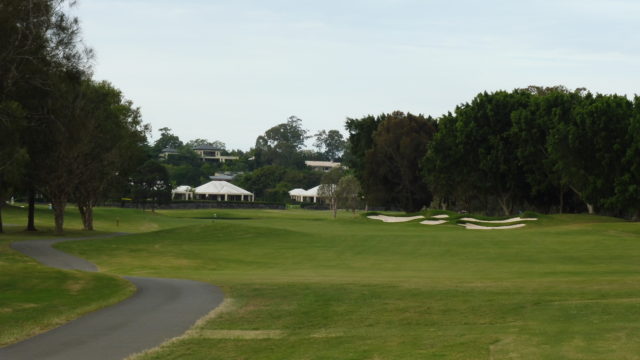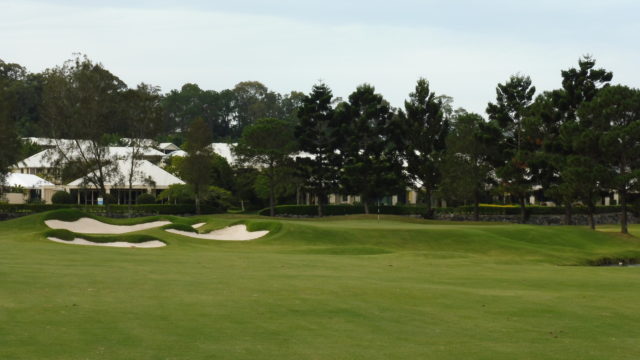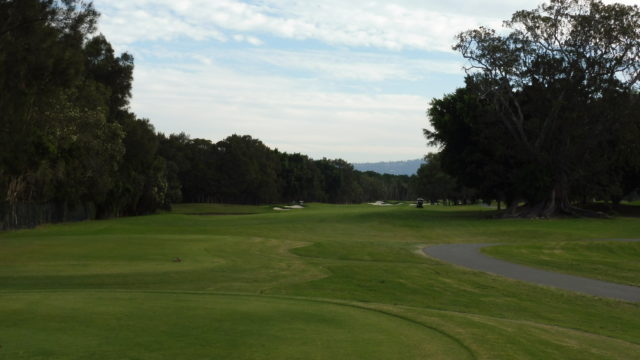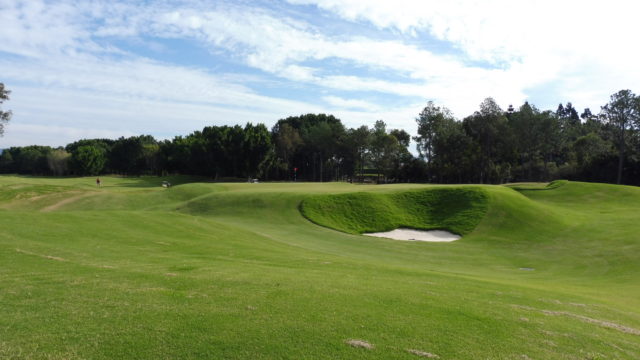
Location: Benowa, QLD
Established: 1990
Architect: Tomojiro Maruyama (1990) / Graham Marsh (2015)
First Played: 19th May 2016
Last Played: 10th July 2018
Magazine Ratings

91 (2020)

92 (Current)

53 (Current)
With the opportunity to play The Grand Golf Club opening up, it was an ideal time to also play the newly revamped RACV Royal Pines Resort Aroona Binnowee course. Having played the old layout in 2013 on a group tour, the course was the weakest we played for the week, I was looking forward to seeing the latest changes for myself. Watching some of the previous Australian PGA Championships had given a little insight into these.

Entrance to RACV Royal Pines Resort
Staying with my old golfing buddy Joe for the night, he decided to also play the course for the first time.

Clubhouse at RACV Royal Pines Resort
The clubhouse caters not only for golf players but guests staying in the on-site accommodation, typical of an RACV venue. I also learnt there is quite a nice restaurant on the upper levels.

Champions Drive – Winners of the Ladies Masters
Over the previous few years, RACV Royal Pines has increased its profile, not only hosting the Australian Ladies Masters since 1992, but also the Australian Mens PGA since its move from Palmer Coolum Resort in 2013.

Koala with Attitude
I came across this brightly coloured koala near the pro shop and was intrigued. This is a part of a campaign, Animals with Attitude Gold Coast Sculpture Trail, which aims to raise awareness for struggles that the koala face. You may come across others throughout the Gold Coast.

Map of RACV Royal Pines
There are three loops of nine available at the course, which gives great choice for players, but also good when course maintenance is required. However the Green and Gold make up the course ranked in the top hundred.
One noticeable changed was the routing was slightly different from my last visit. Holes 1 & 10 remained the same, however 2 to 9 were previously holes 11 to 18.

RACV Royal Pines Scorecard
On the day of play the white tees were used. We were also joined by Phyllis, who was visiting from California.

Hole 1 – 328 meter par 4
From the start it was quite visible in some of the changes that had been made with the redevelopment. This fairly short but straight par 4, previously had bunkers on either side. These had been removed and replaced with one in the center of the fairway.

Undulating 1st green
The next thing noticeable was the amount of mounding and undulations now found in the green complex. Previously most had seem quite flat and uninteresting. A good opening hole which makes the player thing about how to handle the tee shot and approach.

Hole 2 – 141 meter par 3
Having re-routed from the second hole (previously the 11th), is a medium length par 3. With water to the left, although this should really be out of play, except for quite wild shots. A large valley is found leading up to the green, which is surrounded by sand traps.

The 2nd green with the 18th in the background
The next noticeable thing is the shaping of the bunkers, which have a lot more shaping than previously. Quite scenic hole which allows for a range of play, although hitting the target should be the aim.

Hole 3 – 526 meter par 5
Next is the longest hole on the course. From the tee if water intimidates, close your eyes as it runs down either side. Parts of the landing area is hidden by a few trees.

Phyllis playing from the 3rd fairway
Water is found on the last portion of the fairway to the left and rear. On the previous trip algae was found covering most of the surface of the water bodies. This has now been cleaned up and appears a lot more scenic.

Looking over at the 3rd green
Traps are now found on both sides of the green complex, which has a bit more shaping. One of the better par 5 holes on the course.

Hole 4 – 368 meter par 4
A nice medium length par 4 with a slight turn to the right. Water is reachable to the left, so caution is required with club selection.

Approach from the 4th Fairway
Bunkers are in play around the green, which is slightly risen above the fairway. This was one of my favourite holes when previously played and still remained so. Although not suiting my natural shape shot of right to left, the tee shot offers a challenge, which will reward taking an aggressive line.

Hole 5 – 146 meter par 3
Coming to the easiest par 3, this plays along side water to the left, hitting back towards the clubhouse. Some large undulations are found leading into the green, with numerous traps leading in.

Looking back from the 5th green
The green is quite wide, but not overly deep. Mounds are found rear and to the right, whilst the remaining sides slope away. Quite a good par 3 which will test all levels of player, whilst still allowing a range of play.

Hole 6 – 300 meter par 4
A short par 4 playing relatively straight. Water is located right, although will only be in play for mishit shots. Bunkers narrow in from each side the closer you come to the green, which will come into play for those trying to reach the green.

Approach from the 6th Fairway
The majority of this green elevated green has slopes running away, whilst a large false front will repel anything slightly short. Simple hole but has some effective features.

Hole 7 – 367 meter par 4
A longer par 4 with water down the left, this hole has a penal element with the approach via a forced water carry. Being out of position off the tee, may require a layup.

Carry the water between the 7th fairway
The green is quite wide, with plenty of short grass short. One of the challenging holes on the course, which will leave those finding the target in two, with a large smile.

Hole 8 – 280 meter par 4
Next is the shortest and easiest par 4. With water running the entire left side of the fairway. There is ample room however for the tee shot, although the fairway does narrow at one point and a solitary bunker is located in the center as well.

Large undulations around the 8th green
The green is quite elevated requires some thought for the approach, with water still in play down the left and numerous bunkers to the right. New are the number of mounds and hollows, making shots around the green not so simple. Great short hole offering a range of strategies to the player.

Hole 9 – 464 meter par 5
Finishing the front nine is a par 5. With a wide landing area from the tee, a line of trees with one bunker is located right, whilst further trees and water are down the left. The hole turns slightly to the right for the second shot.

Water surrounds the 9th Green
Traps either side lead into the green, which is almost surrounded by water. This makes for a difficult target, one which those attacking will have great reward or risk. Slightly missing the green left can lead to a swim retrieving the ball.

Hole marker for the green course

Hole 10 – 292 meter par 4
Starting the second loop, sees a tee shot to a wide fairway. Water is found left (and right from the back tee), whilst multiple bunkers are staggered down the fairway.

Looking across at the 10th green
There are some significant undulation changes on this green, with a large dip in the middle, quite a stark contrast since the renovations. An easy hole from the front tees, but playing from the back is a totally different hole.

Hole 11 – 363 meter par 4
The second hole, a 363 meter par 4, has a slight dogleg to the left with the ground having a slight slope in the same direction. A bunker is located left to carry, for those trying to shorten the hole. Previously there was a bunker to the right, but no replaced by various mounds. There is quite a bit of room to land your drive however.

Slightly raised 11th green
The previously flat green has been replaced by a slightly raised surface with many small mounds surrounding. One of the rare holes on the course which has directional change, but is pleasant to play.

Hole 12 – 471 meter par 5
Things narrow slightly on the 471 meter par 5 third hole, which is the easiest par 5. Water is in play for any errant shots left off the tee whilst the fairway is cut a little narrower, however there is still ample room between the fairway and trees that line each side. A group of bunkers are in play on the right side for those hitting to the wide side of the fairway.

View from the 12th fairway
Water runs down the last section of the fairway through to the green, on the right. Ample space is available to the left, most being rough (but at least not water), although a large group of bunker sits out this side. Some slight slopes and change in fairway direction along the way bring some interest to the hole.

Hole 13 – 357 meter par 4
A medium length par 4 with water down the right on the first portion of the fairway. Out of bounds is also found left past the line of trees.

Approach from the 13th fairway
A large drainage ditch has now been filled, which ran through the fairway, a noticeable improvement. Raising the green slightly with smaller bunkers also looks much better to the eye. A strategic hole where executing your tee decision is critical.

Hole 14 – 182 meter par 3
Faders beware on the 5th tee (or left handed hookers) – water right and out of bounds left on the longest and hardest par 3. A large slope runs away from the green towards the water.

View of the 14th green
With a large bunker left, the tee shot will need to carry to reach the green. One on the right might be a savior from reaching the water. Good par 3 allowing a variety of play.

Hole 15 – 455 meter par 5
Next is the shortest par 5. With what looks like a narrow fairway from the tee, some hidden dangers lurk close by. A small water hazard hides to the left.

Bunkers on the 15th fairway
Having a slight slope down towards the green, longer hitters may be able to run the ball on without too much issue. A raised green, has bunkers on both sides, however left leaves the more difficult shot. Not the best of the long holes, with uninteresting terrain.

Hole 16 – 112 meter par 3
The shortest hole is also one of the most interesting, now from both tees. Water is in play from both sites, but must be carried to reach the green from the back.

View from the social 16th Tee
From the social tee the hole it is a bit more straight forward, although water is in play for left hand pin positions.
Phyllis playing on the 16th

Looking back from at the 16th green
The biggest improvement is the surrounds on this hole. Previously the green was nestled into the hill side. It is now fully raised on all sides, with numerous mounds and hollows to contend with. Probably my pick of the holes at RACV Royal Pines.

Hole 17 – 319 meter par 4
Play on this shorter par 4 contends with a slight dogleg right. Bunkers are now found down the outside of the corner. A small hill needs to be carried on the inside line to shorten the hole.

Looking back from the 17th green
Numerous bunkers are found around the green, along with small mounding. Nice hole offering a range of play from the tee, but the biggest issue with the hole is the westerly facing direction, playing into the afternoon sun. My guess is this was a better option than having to play the old 18th into the sun.

Hole 18 – 399 meter par 4
Finishing the round is the longest par 4 and hardest hole on the course. Playing relatively straight and down a gentle slope, bunkers are staggered either side and in play.

View from the 18th fairway
Bunkers run down the right of the hole, with the optimum line into the green, being on the left.

Elevated 18th green
The green is quite long, but not overly wide. With bunkers either side, but also to the rear. Sitting quite raised, missing the green will leave a shot up a large slope. Difficult hole where I’m sure a championship or two will be decided.
In summary the course was a great improvement over the last time I played in 2013. This was especially evident with the bunkers and green complexes, where shaping of both had occurred. Previously the greens were relatively flat and mostly level with the fairways, whilst the bunkers looked like large ponds of sand. Many greens now have mounds and hollows surrounding, leaving a variety of shots to be played.
Fairways had also had some improvement, adding some shape, however they still feel relatively flat overall, which is one big detraction to the course.
Looking at the course makeup:
- Hole Directions – There was some variety allowing for conditions to have wide ranging effects during play, although none faced north and only one south. The 2nd has an easterly facing direction which maybe problematic in the morning sun, whilst the 17th has a westerly facing tee, which causes issues late in the afternoon with sun. We had first hand experience of this
- Hole Lengths – Par three holes had a good variance in distance, the majority in mid length. Par four holes ranged from short to long with the majority being either short or mid length. Par 5 holes ranged from mid to long and were evenly split
- Hole Layout – There was a mixture in how the holes played, although an overwhelming majority tended to favour turns to the right, where two shots or more were required to reach the green. This outnumbered those turning to the left more that two to one
Is this a course I would race out again to play? Probably not, as I still favour some of the other courses on the Gold Coast a bit more. I do commend though the work that has been carried out on creating a huge improvement to the course.
How to play at RACV Royal Pines:
1. This is a public course. Please contact the pro shop or book your tee time on-line

